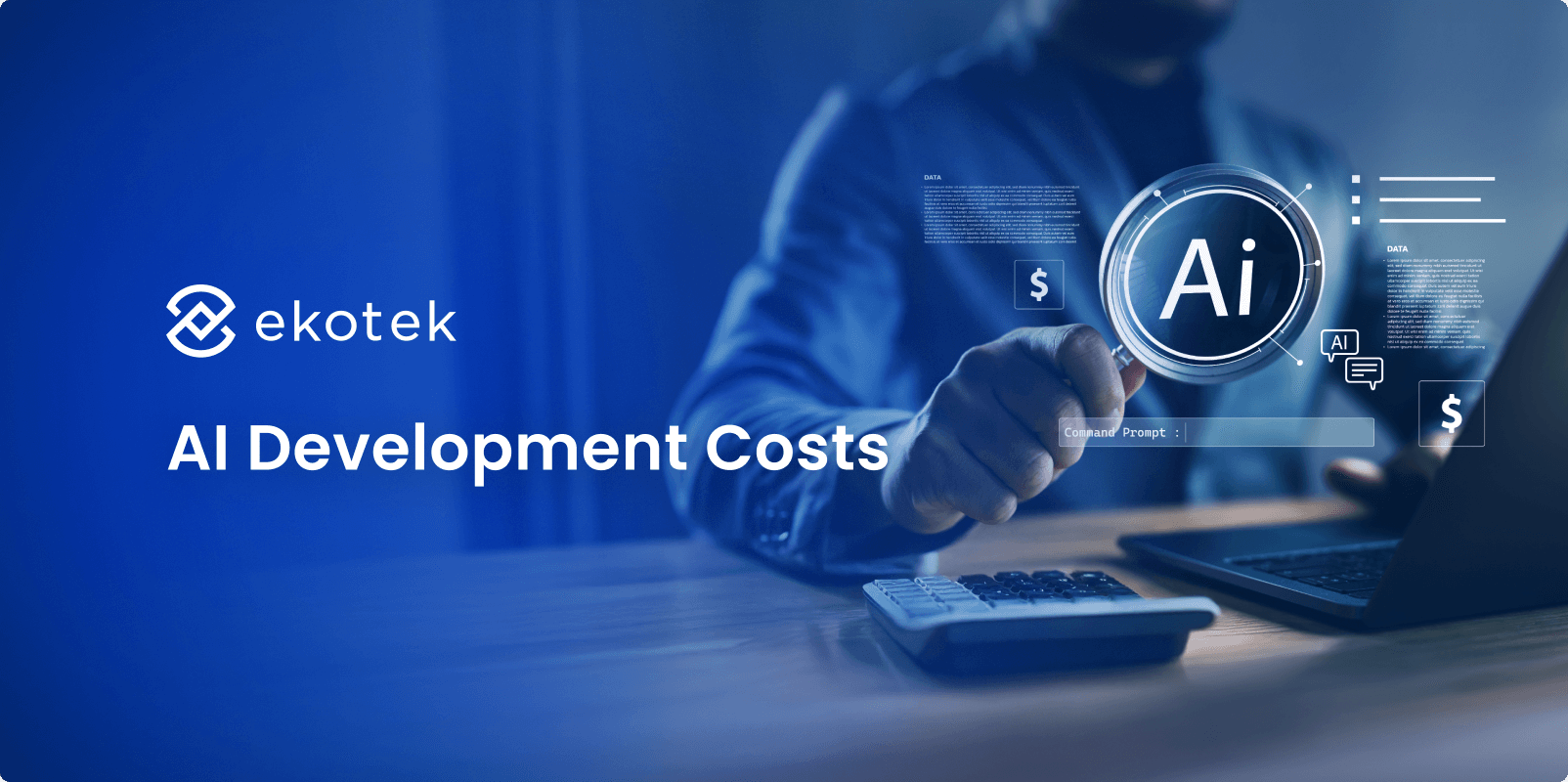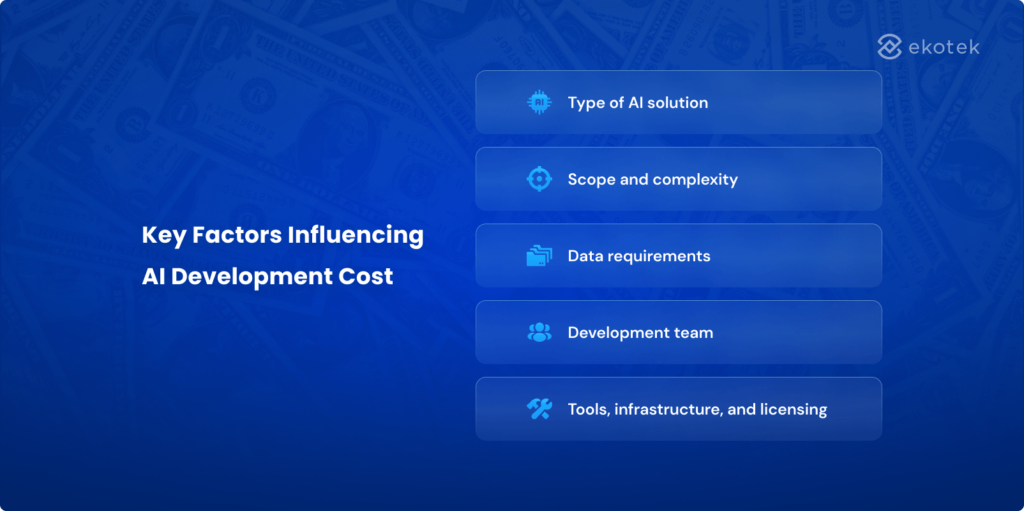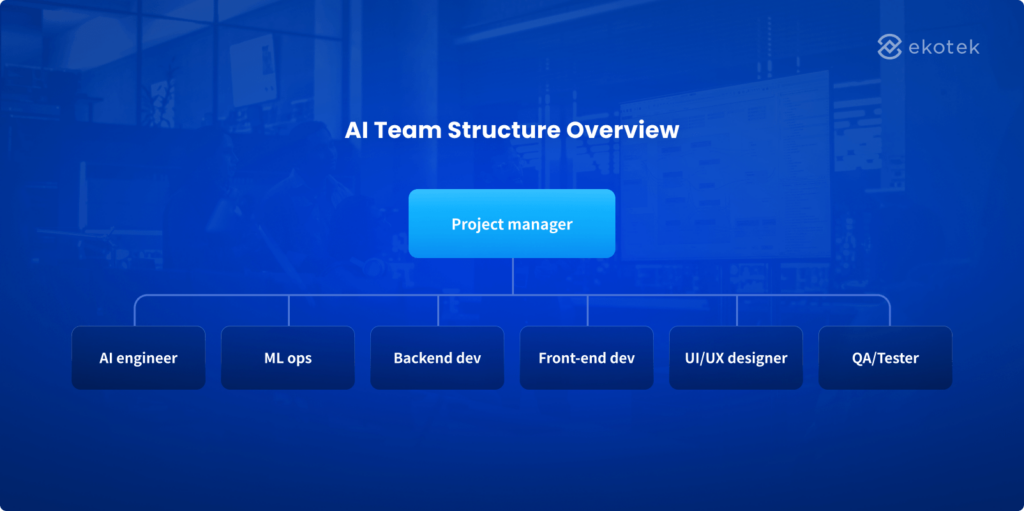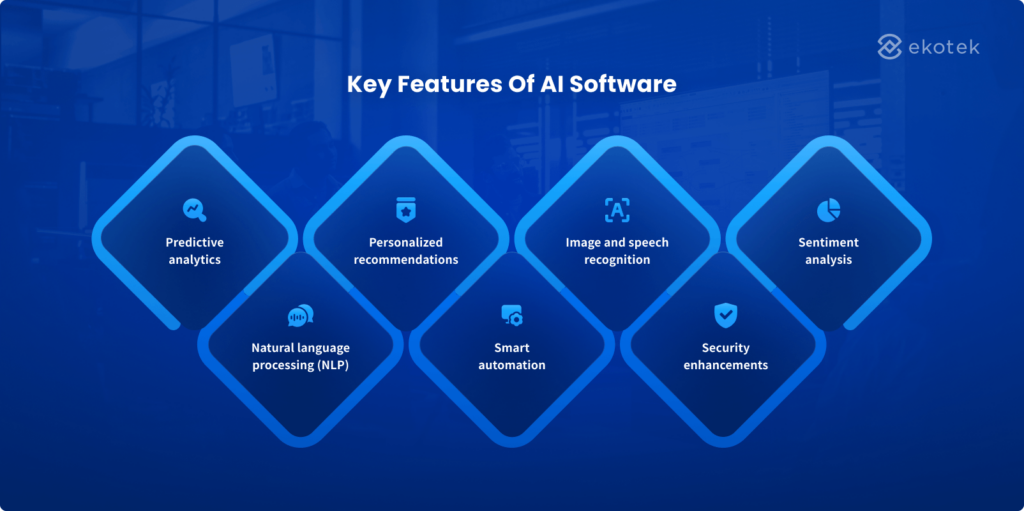
- 1
- 2
- 3
- 4
- 5
- 6
Introduction
As artificial intelligence (AI) continues to revolutionize how businesses operate, more organisations are looking to invest in AI-driven solutions to stay competitive. From automating routine tasks to unlocking powerful insights through data, AI offers transformative benefits across industries. According to IDC, global spending on AI-centric systems, including software, hardware, and services, is projected to surpass $300 billion by 2026.
But one of the most common and critical questions decision-makers ask is: “How much does ai cost?”. In this blog, we’ll explore the key factors that influence AI development cost and provide a breakdown of typical cost components.
Key factors influencing AI development cost

Type of AI solution
One of the primary drivers of cost is the type of AI solution you choose to implement. Not every AI system is built with the same technology, and the differences are substantial:
- Rule-based systems: These systems are simple to build and ideal for handling predefined tasks. They follow fixed if-then rules and require minimal computing power.
- Machine learning solutions: ML systems analyze data and improve over time. They require a quality dataset and continuous tuning, leading to higher development and maintenance costs.
- Deep learning models: These models excel in tackling complex tasks like image or voice recognition. They demand large datasets, advanced algorithms, and high-end hardware, making them the most expensive to develop.
| Type of AI solution | Description | Example | Estimated cos |
|---|---|---|---|
| Rule-based | Simple logic-driven systems | FAQ chatbot | $5,000 – $15,000 |
| Machine learning | Data-driven systems that learn over time | Predictive maintenance in manufacturing | $20,000 – $100,000 |
| Deep learning | Complex AI requiring large data and computer power | Medical image recognition | $500,000 |
Scope and complexity
Another layer influencing cost is the project’s scope and inherent complexity. AI projects vary widely, and factors such as the number of features, integration points, and required performance levels matter greatly.
- Basic AI application: A simple sentiment analysis tool that evaluates customer feedback typically costs between $20,000 and $40,000. This requires minimal features and straightforward programming, making it accessible for businesses looking for an entry-level solution.
- Mid-level AI application: A product recommendation engine with analytics falls into the mid-range category, costing between $50,000 and $100,000. This type of application needs more advanced algorithms to analyze user behavior and preferences, which adds to the complexity and cost.
- Advanced AI application: An advanced solution, such as a multilingual AI assistant with real-time insights, can exceed $150,000. This application is complex due to extensive language processing, high-performance requirements, and the capability to operate across multiple platforms simultaneously.
Data requirements
Data is the backbone of any AI initiative, yet preparing that data for effective use is often underestimated. Understanding the various components involved in data preparation is crucial for budgeting effectively.
- Data collection: Acquiring data can occur through various methods, including sensors, APIs, or manual input. Each method has its own costs associated, such as purchasing data from third-party sources or investing in hardware for data collection.
- Data cleaning and labelling: Raw data is often messy and unstructured. Cleaning ensures the data is usable, while labelling is essential for supervised learning models. These tasks can be labor-intensive and time-consuming, especially if done manually, leading to increased costs.
- Data storage and access: Storing and accessing data involve additional infrastructure costs. Businesses can choose between cloud-based solutions, which offer scalability and ease of access, or on-premises systems, which may require significant upfront investment in hardware and maintenance.
| Data requirements | Description | Example | Estimated cost |
|---|---|---|---|
| Data collection | Obtain raw data through APIs, sensors, or third-party providers | IoT and logistics data for supply chain AI | $1,000 – $10,000+ |
| Data cleaning and labelling | Prepare and annotate data for training | Labelling 50,000 images for defect detection | $5,000 - $50,000 |
| Data storage and access | Store and access training/inference data | Customer data on the cloud for analytics AI | $10 – $100 per Terabyte/month |
Development team
The human element is often the most variable in determining cost. Your development team’s makeup and where they are based can greatly influence your overall budget.
1. In-house vs outsourced
In-house development offers full control and closer collaboration but comes with higher costs and long-term overhead. Outsourcing provides access to specialized talent and lower labor costs, though it may introduce challenges in communication or project alignment.
⭐️ You may need an outsourcing software vendors evaluation checklist – Download it here →
| Factors | In-house team | Outsourced team |
|---|---|---|
| Control | Full control over the process and priorities | Less direct control |
| Initial cost | High (salaries, recruitment, tools) | Lower (project-based pricing, low upfront cost) |
| Talent acquisition | Time-consuming, requires HR involvement | Immediate access to experienced specialists |
| Infrastructure investment | Required (tools, workspace, hardware) | Typically included in vendor pricing |
| Maintenance and support | Handled internally with ongoing cost | Handled by the vendor |
| Communication | Easier, faster | Potential delays, time zone/language issues |
| Knowledge retention and IP risks | Higher knowledge continuity | Must ensure legal safeguards for IP |
| Flexibility | Less scalable in short-term | Easy to scale up/down based on project scope |
Regional cost differences
The cost rates for developers vary widely by region, which impacts the total development budget. Businesses often offshore or nearshore to balance cost and capability.
🔹 United States or Western Europe:
- High-quality talent
- Cost: $80,000 – $200,000+ per year
🔹 Eastern Europe:
- Strong technical education, good English
- Cost: $30,000 – $80,000 per year
🔹 Southeast Asia:
- Lower labor cost, growing talent pool
- Cost: $20,000 – $50,000 per year
🔹 India:
- Large talent pool, competitive rates
- Cost: $15,000 – $40,000 per year
⭐️ Read more: Which software outsourcing countries in Asia are best for you?
Key roles involved
A successful AI project typically requires a multidisciplinary team including data scientists, machine learning engineers, software developers (both backend and frontend), and project managers. Each role brings its own cost and expertise, and the balance of these will influence the overall cost structure.

Tools, infrastructure, and licensing
AI development relies on a robust technical stack that includes advanced computing environments, specialized software libraries, and licensing agreements.
Cloud computing and storage
AI applications demand significant computational power:
- Providers like AWS, Azure, and Google Cloud offer flexible services, but costs vary based on usage: Compute instances (e.g., GPUs/TPUs), storage space for training data and models, data transfer bandwidth
- Cost impact: Monthly expenses can range from $500 to $5,000+, depending on the size and complexity of the AI workload.
ML frameworks and libraries
Common ML libraries like TensorFlow, PyTorch, and scikit-learn are open-source (free to use). However, using them effectively at scale requires:
- Skilled engineers for setup and optimization
- Enterprise support or managed services (optional, but may be necessary for larger systems)
Third-party tools
External tools may be needed for:
- Data labeling (e.g., Scale AI, Labelbox)
- Analytics dashboards (e.g., Tableau, Power BI)
- Model monitoring or automation services
Cost impact:
- Licensing can be annual or usage-based
- Pricing ranges from $2,000 to $15,000+ per year, depending on features and user volume
Key features of AI software development
A robust AI solution incorporates features that significantly enhance business operations. Key features include:
- Predictive analytics: AI leverages historical data to forecast trends, enabling better resource allocation and proactive maintenance.
- Natural language processing (NLP): NLP allows systems to understand and generate human language, powering chatbots, virtual assistants, and automated customer support.
- Personalized recommendations: AI analyzes user behavior to offer tailored suggestions, enhancing customer satisfaction and boosting sales in e-commerce and content platforms.
- Smart automation: By automating routine tasks, AI helps reduce errors and operational costs while freeing up human resources for strategic work.
- Image and speech recognition: These capabilities are indispensable in applications such as security, accessibility, and quality control.
- Security enhancements: AI-driven monitoring quickly identifies anomalies and potential threats, providing a stronger cybersecurity posture.
- Sentiment analysis: By analyzing social media, reviews, and customer feedback, AI helps businesses understand public perception and fine-tune their strategies.
Each feature requires specific development efforts and integrations, impacting overall costs. Businesses must decide which features are essential for their unique needs, balancing functionality with budget constraints.

Comparing custom AI vs ready-made AI solutions
When planning an AI project, you must decide whether to develop a custom solution or opt for ready-made products:
- Custom AI solutions: These are tailored to your specific business requirements. However, custom solutions often require a higher upfront investment and longer development cycles. For example, developing a custom AI-driven customer relationship management (CRM) system might cost between $100,000 and $500,000, depending on the complexity and features required.
- Ready-made AI solutions: Off-the-shelf products allow for rapid deployment and lower initial costs. For instance, a ready-made AI-powered customer support platform might cost between $10,000 and $50,000. The trade-off, however, is that these solutions can be less adaptable and may not integrate perfectly with your internal systems.
| Criteria | Custom AI solution | Ready-made AI solution |
|---|---|---|
| Customization | Fully tailored to specific business needs | Limited customization options |
| Integration | Seamlessly integrates with internal tools and systems | May face compatibility issues with existing systems |
| Scalability | Scale with business growth | Limited scalability |
| Time to deploy | Longer development timeline | Fast deployment |
| Upfront cost | High initial investment ($100,000 - $500,000+) | Lower upfront cost ($10,000 - $50,000) |
| Data security | Full control over data compliance | Limited visibility depending on provider policies |
| Ideal for | Complex, high-impact projects with unique business logic | Standard use cases with minimal need for customization |
For businesses with unique workflows, high data security needs, or rapidly evolving markets, custom AI is often the wiser long-term investment. In contrast, companies seeking quick wins or with limited budgets might lean toward ready-made solutions, provided they accept the limitations in customization and scalability.
Development stages cost estimation
AI projects typically progress through several stages, each of which has distinct costs:
- Discovery and data preparation: In this stage, businesses define goals and gather requirements through stakeholder interviews. Simultaneously, data is cleansed, formatted, and labelled to ensure readiness for training. This foundational work is crucial for success, with costs ranging from $10,000 to $50,000.
- Model training and integration: This phase focuses on training the AI model using prepared data, which requires significant computing power and iterative refinement. The model is then integrated into existing systems, involving custom interfaces and application logic. Costs for this stage typically range from $50,000 to $200,000.=
- Deployment and monitoring: The final stage involves rolling out the system, conducting thorough testing, and ensuring ongoing performance through monitoring. This phase also includes iterative improvements based on user feedback. Ongoing expenses can range from $20,000 to $100,000 annually.
⭐️ Read more about A step-by-step guide to integrate AI into businesses
How Ekotek can help with AI software development
Ekotek provides end-to-end AI development services for businesses across industries like banking, manufacturing, retail, and healthcare. With years of experience and a skilled team, we deliver scalable, cost-efficient solutions that address real-world challenges. We are well-versed in leading frameworks and models such as LangChain, TensorFlow, OpenCV, OpenAI, and PaLM 2, supporting a wide range of AI applications.
We offer a wide range of AI development services, including:
⭐️ AI strategy consulting: Identify the right AI approach based on in-depth business analysis
⭐️ Custom generative AI software: We create customized chatbots, conversational interfaces, and more, powered by advanced generative AI technologies.
⭐️ Computer vision: Whether you need video recognition, image analysis, or other computer vision solutions, our experts in machine learning, NLP, and data analysis can help.
⭐️ Generative AI integration: Integrate models like ChatGPT into your existing systems with custom behavior at a low cost and rapid integration.
⭐️ Data services: We dive into the details of your business needs to develop a functional AI prototype, driving AI modelling, customization, optimization, and proof of concept creation.
⭐️ Deployment: Ekotek handles the entire deployment process, from testing, fine-tuning to full-scale implementation.
If you’re ready to embark on your AI journey or scale an existing system, contact Ekotek for a personalized consultation and detailed cost estimate.
Closing thoughts
The cost of AI development is influenced by a myriad of factors, ranging from the type and complexity of the solution to the data required, the development team involved, and the infrastructure needed for seamless integration. As businesses explore AI to drive innovation, it’s crucial to account for these variables when planning your investment.
Ekotek is a trusted partner for AI development services, equipped with deep industry knowledge and expertise. Our services are designed to meet your business needs while staying within budget. Whether you’re looking for a fixed-scope project or prefer a team extension model, we ensure cost-effectiveness without compromising quality.
Ready to start your AI journey? Contact us today for a tailored cost estimation and discover how we can help you transform your business through intelligent, data-driven solutions.
- 1
- 2
- 3
- 4
- 5
- 6